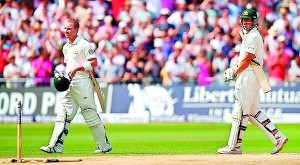‘I knew I was gone’: Haddin
Australia’s agony at narrowly missing out on an opening Ashes Test triumph has been quickly overshadowed by fresh off-the-field matters.
Brad Haddin didn’t need to wait for the replay to know he had hit the ball that sealed Australia’s first-Test defeat. And he said he had no problem with Stuart Broad’s decision not to walk earlier in the Test.
”I hit it, so I knew I was gone,” said Haddin, who stood, pale and exhausted, in the middle of the pitch with James Pattinson and waited for the third umpire to make his fate official.
”It didn’t go right to plan,” Haddin said of his valiant but ultimately unsuccessful innings. ”I would have liked to see it right through. I didn’t do my job in the end.”

Brad Haddin (on left) with Ashton Agar at Trent Bridge during the first Ashes Test.
Haddin, whose edge ended the first Test, stood and waited for England’s review to convict him, and had no problem with Broad’s decision not to walk. ”It’s a personal choice. I see nothing wrong with what Stuart did. The umpire is there to make the decision and he has seen it different to everyone else.” Haddin’s 71 from 147 balls might not have delivered victory, but it did reveal something of Australia’s plan to exhaust England’s best bowler, Jimmy Anderson. The plan is not foolproof – Anderson was man of the match with 10 wickets for the game and got Haddin in the end.
But the Australian vice-captain confirmed that his tactic was to hit Steven Finn out of the attack so England would be forced to bowl Anderson for more overs than it wanted to.
”Obviously Jimmy was the difference,” Haddin said. ”He was at you the whole time. I had the opportunity when Finn came on to force the game a little bit. I had the feeling England didn’t really want to bowl him. I was always going to go then and see where it got to, see if they could bring Jimmy and that back quicker than they wanted to. In the end it worked against me, he got me in the end.”
Haddin hit Finn for 15 runs in six balls including three consecutive boundaries, while figuring that the only way to score against Graeme Swann was to sweep him. Anderson left the field with cramp but returned after the late lunch break to take the last wicket.
Haddin said the Australians would try to make him bowl as many overs as possible over the course of a five-Test series.
”He has shown over a long period of time that he has got a pretty big engine. It’s obvious he is the one we’ve got to work through, he bowled extremely well in difficult conditions for fast bowlers,” Haddin said.
”It’s important to get him bowling a lot of overs.”
England coach Andy Flower denied his side was too dependent on Anderson.
”When you’ve got great players in your side they will affect games but a lot of our guys stood up and performed well in this match. It’s not one-man performing,” Flower said.
Finn is expected to come under pressure from Tim Bresnan or Graham Onions, although Flower said he had made crucial breakthroughs in the first innings.
”We only had just over 200 on the board and he got (Shane) Watson early and (Ed) Cowan first ball. Those were crucial breakthroughs for us. That sort of striking is one of the things he’s capable of with pace and bounce.”
Haddin saw enough good signs in the tourists’ performance to feel confident of a strong response at Lord’s, where Australia has lost just six out of 36 Tests in 129 years.
Follow @timesonlinelk
comments powered by Disqus


